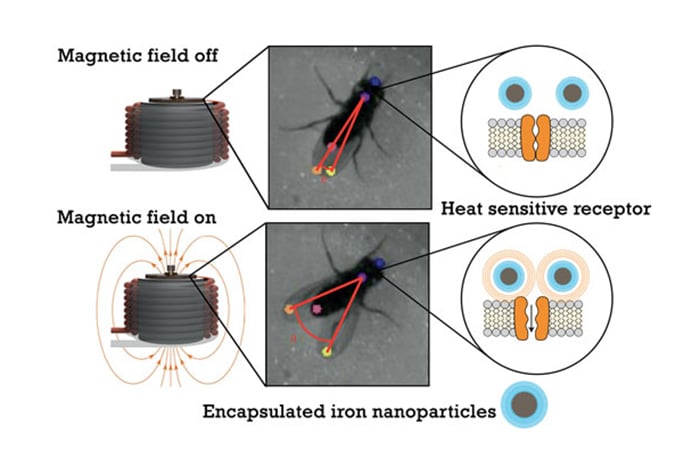A research team led by Rice University neuroengineers has created wireless technology to remotely activate specific brain circuits in fruit flies in under one second.
The team – an assemblage of experts in genetic engineering, nanotechnology, and electrical engineering – used magnetic signals to activate targeted neurons that controlled the body position of freely moving fruit flies in an enclosure.
The researchers first created genetically modified flies bred to express a special heat-sensitive ion channel in neurons that cause flies to partially spread their wings, a common mating gesture. They then injected magnetic nanoparticles that could be heated with an applied magnetic field.
When researchers activated a magnetic field in the flies’ enclosure, the nanoparticles converted magnetic energy to heat, firing the channels and activating the neurons. An overhead camera filmed flies as they roamed freely during experiments, and a visual analysis showed flies with the genetic modifications assumed the wing-spread posture within approximately half a second of receiving the magnetic signal.

“To study the brain or to treat neurological disorders, the scientific community is searching for tools that are both incredibly precise, but also minimally invasive,” said the study author Jacob Robinson, an associate professor in electrical and computer engineering at Rice and a member of Rice’s Neuroengineering Initiative. “Remote control of select neural circuits with magnetic fields is somewhat of a holy grail for neurotechnologies. Our work takes an important step toward that goal because it increases the speed of remote magnetic control, making it closer to the natural speed of the brain.”
He said the new technology activates neural circuits about 50 times faster than the best previously demonstrated technology for magnetic stimulation of genetically defined neurons.
Researchers are hopeful that the ability to activate genetically targeted cells at precise times could be a powerful tool for studying human brain function, treating neurological diseases, and developing direct brain-machine communication technology.
Robinson is a principal investigator for the US military‘s DARPA-funded project MOANA (magnetic, optical, and acoustic neural access), which aims to develop headset technology for nonsurgical, wireless, brain-to-brain communication. If all goes to plan, the MOANA headsets will both read (decode) neural activity in one person’s visual cortex and write (encode) that activity in another person’s brain. However, Robinson says the goal is still a long way off.
“The long-term goal of this work is to create methods for activating specific regions of the brain in humans for therapeutic purposes without ever having to perform surgery,” Robinson said. “To get to the natural precision of the brain, we probably need to get a response down to a few hundredths of a second. So there is still a ways to go.”
Neuroengineers hack fruit fly brain and remotely control its movements
Source: Global Access News

No comments:
Post a Comment